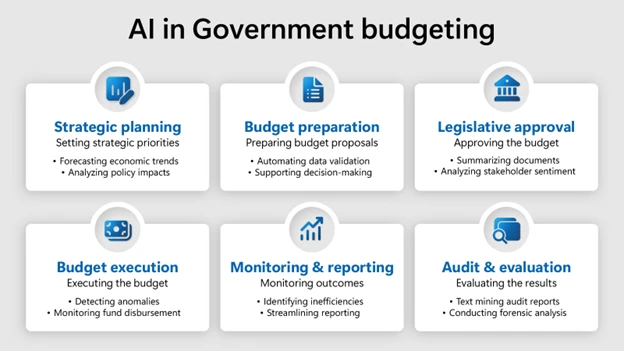
Modernize public finance with AI: Informed budgeting for economic growth
Government finance leaders today face a new budgeting imperative: moving from economic recovery to resilience. As trillions of dollars are spent on economic growth, the public expects transparency from their leaders and wants to see the measurable impact of funds spent.
To make every budgeted dollar count towards economic growth, finance leaders should shift towards informed budgeting. Informed budgeting uses performance metrics, citizen needs, and economic forecasts to allocate resources more effectively. Here’s how this approach can benefit public finance agencies and economies:
- Informed decision making: Get real-time insights into budget requests and the impact of budget allocations across government programs, agencies, and the broader economy.
- Economic resilience: Ensure budgets are adaptable to shocks and capable of sustaining critical services during crises.
- Financial inclusion: Allocate funds and programs to underserved communities and businesses to ensure that growth is widely shared.
- Cross-agency collaboration: Break down silos between departments to share data and insights for coordinated, strategic investments.
Traditional budgeting approaches are no longer sufficient. Many government finance systems still operate in analog silos, where each department plans independently, making it difficult to address outcomes that span multiple sectors. Legacy systems also limit agility. Analysts spend significant time gathering supporting information and manually modeling accurate forecasts or quickly simulating the reallocation of funds in response to changing economic conditions. The result can be budgets that are misaligned with real-world needs and policy goals or that lack timely impact.
To deliver proactive, transparent, and data-driven budgeting to the public, budget and treasury agencies need to modernize budget planning and execution. Microsoft collaborates with governments globally to unlock the new opportunities and capabilities that AI advancement bring towards the goal of economic growth.
Informed decision making
Informed decision-making is critical for public finance agencies because it ensures that budget planning and execution are grounded in real-time data and insights. This approach allows for more accurate forecasting, prioritization of resources based on actual needs, and strategic allocation that maximizes impact across individuals, communities, and businesses—while also enhancing transparency, accountability, and public trust in financial governance.
- Advanced data analytics and AI for forecasting: By using AI, agencies can analyze historical economic data and run ‘what-if’ scenarios with greater accuracy. The following solutions allow officials to proactively adjust plans rather than react.
- Predictive analytics: Forecast economic trends and simulate policy impacts.
- Natural language processing: Analyze public sentiment and policy documents.
- Scenario modeling: Evaluate different policy trade-offs.
- Real-time reporting and analytics: Modern reporting tools like Microsoft Power BI and Azure data analytics let agencies to build live dashboards that track spending against KPIs. Live dashboards provide near-real-time visibility into fund usage and achieved results, allowing budget officers to monitor allocations and correlate spending with economic indicators for timely adjustments. Outcome-based budgeting becomes possible, linking allocations to metrics such as gross domestic product (GDP) growth or poverty reduction. This allows continuous feedback between spending and impact.
Economic resilience
To foster economic growth and resilience, government budgeting must become more predictive, agile, and outcome-focused. Leading agencies are transitioning from static annual budgets toward dynamic forecasting and continuous re-planning with modern technologies.
- Integrated budget management systems: Modern cloud-based enterprise resource planning (ERP) systems like Microsoft Dynamics 365 Finance provide end-to-end budgeting, accounting, and reporting on a single platform. This integration allows seamless data flow from planning to execution to audit, reducing errors and manual work.
- Process reengineering and automation for execution: Automation ensures that budgets are executed efficiently. With low-code automation, organizations are empowered to improve fund distribution, grants management, and procurement, allowing money to move out faster and more accountably.
- Cultural change: Transitioning from annual, siloed cycles to agile, collaborative budgeting requires a cultural shift. Agencies may need to update regulations for mid-year adjustments and foster a culture of data-driven decision-making and interdepartmental cooperation. Pilot projects can demonstrate quick wins and build support.
- Upskilling the workforce: Technology adoption is effective only when staff can interpret data insights and adapt policies as needed. Agencies should invest in training finance professionals in data science, AI, and modern systems. For public finance agencies, Microsoft offers training for enhance public sector services with generative AI, Microsoft Dynamics 365 Finance, and finance-specific use cases with Microsoft 365 Copilot.
Financial inclusion
Finance agencies are expected to allow access to funds and programs while balancing inclusivity and reach across communities and businesses. To achieve this, they need insights into real-time needs and gaps. They must establish streamlined access as well as strong eligibility checks so they can move resources securely, effectively, and quickly.
- AI-powered taxpayer-centric models: Agencies can better understand the diverse needs of individuals and businesses by mapping life events to financial touchpoints. Collaborating with banks and financial technology companies creates a seamless service delivery. Agencies that conduct gap assessments with central banks and regulators can identify underserved populations and tailor inclusive strategies.
- Streamlined intake and eligibility checks: Service interactions can be simplified through unified customer accounts and identity systems, and low-code automation. This allows instant access through intelligent portals and virtual assistants while also accelerating decision-making with automated eligibility checks.
- Transparency and citizen engagement: Informed budgeting involves engaging the public by transparently sharing plans and results. Online portals allow citizens to view allocations and provide feedback, leading to better-aligned projects and increased trust.
Cross-agency collaboration
Achieving economic growth through budgeting requires collaboration across all government sectors—not just finance ministries. For example, a nationwide upskilling program might involve the treasury for funding, the education ministry for implementation, and the labor department for outcome tracking. If departments operate in silos, programs can falter.
- Unified data sharing: Modern platforms allow departments to securely share data and insights. Cloud-based data hubs and collaboration tools such as Microsoft Intelligent Data Platform and Microsoft Teams allows for a consolidated view of economic initiatives. Planners can evaluate performance across all government sectors to inform future funding decisions.
- Cross-functional budget task forces: Some governments establish interagency teams to oversee major spending initiatives. These teams use digital project management and analytics tools to coordinate efforts. Collaboration ensures that support reaches the right beneficiaries at the right time, enhancing inclusion and growth.
- Security and compliance: Government financial data and cloud solutions require rigorous security and privacy, especially when data is shared across departments. Microsoft’s public sector cloud services emphasize compliance, identity management, and data protection, giving public finance officers confidence in the security and trustworthiness of the systems they use.
The impact of AI on informing budgeting
Government budget planning and execution is a structured process that ensures public resources are allocated effectively and transparently. From the first step to the last, the process and the people can be supported by AI.

Strategic planning and policy formulation are the initial steps where governments define macroeconomic goals and align departmental plans with national priorities. AI can enhance this phase through predictive analytics, scenario modeling, and natural language processing to analyze trends and public sentiment.
During budget preparation, ministries and agencies submit proposals that central authorities review and consolidate. AI streamlines this step by automating data validation, prioritizing projects using decision-support algorithms, and assisting users with chatbots.
During the legislative approval phase, AI tools can summarize complex documents, analyze stakeholder sentiment, and simulate the impact of proposed amendments. Once the budget is approved, execution involves fund disbursement, procurement, and project implementation. In this phase, AI supports robotic process automation, fraud detection in procurement, and real-time monitoring dashboards.
Monitoring and reporting follow, where AI detects anomalies, automates reporting, and uses geospatial tools to track project delivery. In the audit and evaluation phase, AI aids in text mining audit reports, conducting forensic analysis, and assessing program outcomes.
Throughout all stages, AI enhances transparency, interoperability, and capacity building, making the budgeting process more efficient, accountable, and responsive.
Success stories: Informed budgeting in action
- City of Columbus (US): Columbus modernized its financial management by adopting Dynamics 365 to handle its complex finances. This system oversees more than 150 departmental budgets, 3,500 capital projects, and 9,000 forecast positions with automated workflows and multi-level approvals, ensuring transparency and compliance. The city’s approach serves as a model for others upgrading legacy systems.
- City of Redmond (US): Redmond used Dynamics 365 to streamline operations and enhance financial visibility across 500 departments and 82 budget owners. The upgrade created automated workflows, centralized purchasing and accounts payable, and real-time data access. The city identified $3.6 million in savings and filled a $6 million public safety levy gap.
- Municipality of Breda (Netherlands): Breda modernized public service delivery by adopting Microsoft Copilot to address staffing shortages and heavy workloads, empowering 3,600 employees to focus on complex policy issues. Breda piloted more than 25 AI-powered use cases including document drafting, email management, and multilingual migrant support—saving up to 28 hours per employee monthly.
- Somerset Council (UK): Somerset Council used Dynamics 365 to unify five previously separate councils under a single compliant system, replacing 50 disconnected applications and four enterprise resource planning systems—all within 10 months. The council now oversees financial operations across 5,000 staff and multiple service areas with automated workflows, centralized data, and integrated reporting.
- Johor Corporation (Malaysia): JCorp used Microsoft solutions to unify its diverse business segments, eliminate silos, and accelerate data-driven decision-making across more than 500 users and more than 100 AI use cases. The organization centralized data, streamlined collaboration, and embedded AI into workflows for real-time insights, automated documentation, and scenario planning.

Support from Microsoft
Informed budgeting is transforming public finance from a reactive exercise into a proactive strategy for growth. By using data, cloud technology, and teamwork, governments can ensure public funds drive outcomes that lead to stronger economies and greater public trust.
The journey is ongoing. Microsoft and our partners are ready to assist your organization in this process. To learn more about how our technology and expertise can help your agency implement informed budgeting, visit the Microsoft for public finance page today.




